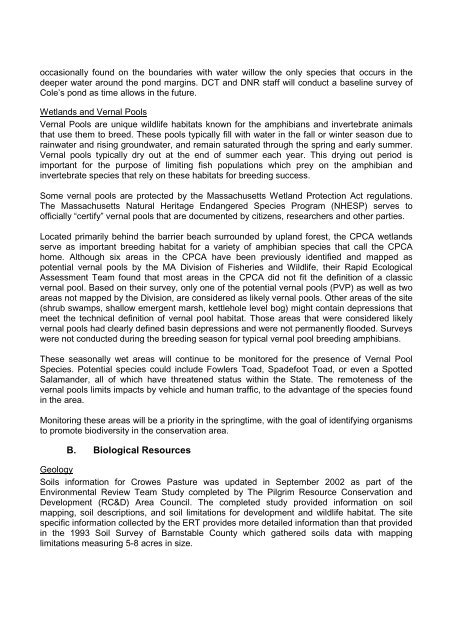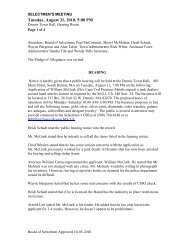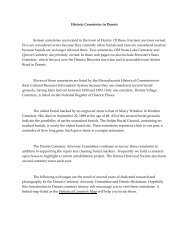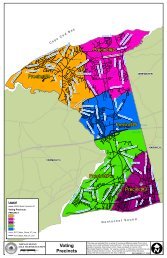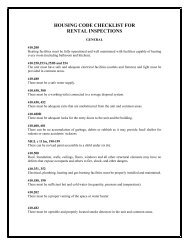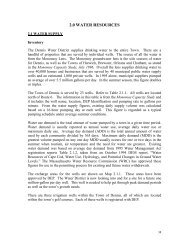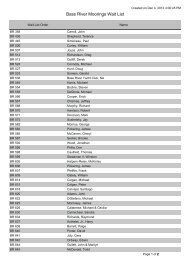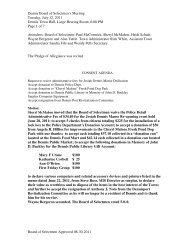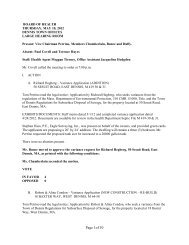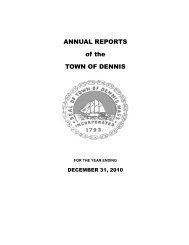Stewardship Plan - the Town of Dennis
Stewardship Plan - the Town of Dennis
Stewardship Plan - the Town of Dennis
You also want an ePaper? Increase the reach of your titles
YUMPU automatically turns print PDFs into web optimized ePapers that Google loves.
occasionally found on <strong>the</strong> boundaries with water willow <strong>the</strong> only species that occurs in <strong>the</strong><br />
deeper water around <strong>the</strong> pond margins. DCT and DNR staff will conduct a baseline survey <strong>of</strong><br />
Cole’s pond as time allows in <strong>the</strong> future.<br />
Wetlands and Vernal Pools<br />
Vernal Pools are unique wildlife habitats known for <strong>the</strong> amphibians and invertebrate animals<br />
that use <strong>the</strong>m to breed. These pools typically fill with water in <strong>the</strong> fall or winter season due to<br />
rainwater and rising groundwater, and remain saturated through <strong>the</strong> spring and early summer.<br />
Vernal pools typically dry out at <strong>the</strong> end <strong>of</strong> summer each year. This drying out period is<br />
important for <strong>the</strong> purpose <strong>of</strong> limiting fish populations which prey on <strong>the</strong> amphibian and<br />
invertebrate species that rely on <strong>the</strong>se habitats for breeding success.<br />
Some vernal pools are protected by <strong>the</strong> Massachusetts Wetland Protection Act regulations.<br />
The Massachusetts Natural Heritage Endangered Species Program (NHESP) serves to<br />
<strong>of</strong>ficially “certify” vernal pools that are documented by citizens, researchers and o<strong>the</strong>r parties.<br />
Located primarily behind <strong>the</strong> barrier beach surrounded by upland forest, <strong>the</strong> CPCA wetlands<br />
serve as important breeding habitat for a variety <strong>of</strong> amphibian species that call <strong>the</strong> CPCA<br />
home. Although six areas in <strong>the</strong> CPCA have been previously identified and mapped as<br />
potential vernal pools by <strong>the</strong> MA Division <strong>of</strong> Fisheries and Wildlife, <strong>the</strong>ir Rapid Ecological<br />
Assessment Team found that most areas in <strong>the</strong> CPCA did not fit <strong>the</strong> definition <strong>of</strong> a classic<br />
vernal pool. Based on <strong>the</strong>ir survey, only one <strong>of</strong> <strong>the</strong> potential vernal pools (PVP) as well as two<br />
areas not mapped by <strong>the</strong> Division, are considered as likely vernal pools. O<strong>the</strong>r areas <strong>of</strong> <strong>the</strong> site<br />
(shrub swamps, shallow emergent marsh, kettlehole level bog) might contain depressions that<br />
meet <strong>the</strong> technical definition <strong>of</strong> vernal pool habitat. Those areas that were considered likely<br />
vernal pools had clearly defined basin depressions and were not permanently flooded. Surveys<br />
were not conducted during <strong>the</strong> breeding season for typical vernal pool breeding amphibians.<br />
These seasonally wet areas will continue to be monitored for <strong>the</strong> presence <strong>of</strong> Vernal Pool<br />
Species. Potential species could include Fowlers Toad, Spadefoot Toad, or even a Spotted<br />
Salamander, all <strong>of</strong> which have threatened status within <strong>the</strong> State. The remoteness <strong>of</strong> <strong>the</strong><br />
vernal pools limits impacts by vehicle and human traffic, to <strong>the</strong> advantage <strong>of</strong> <strong>the</strong> species found<br />
in <strong>the</strong> area.<br />
Monitoring <strong>the</strong>se areas will be a priority in <strong>the</strong> springtime, with <strong>the</strong> goal <strong>of</strong> identifying organisms<br />
to promote biodiversity in <strong>the</strong> conservation area.<br />
B. Biological Resources<br />
Geology<br />
Soils information for Crowes Pasture was updated in September 2002 as part <strong>of</strong> <strong>the</strong><br />
Environmental Review Team Study completed by The Pilgrim Resource Conservation and<br />
Development (RC&D) Area Council. The completed study provided information on soil<br />
mapping, soil descriptions, and soil limitations for development and wildlife habitat. The site<br />
specific information collected by <strong>the</strong> ERT provides more detailed information than that provided<br />
in <strong>the</strong> 1993 Soil Survey <strong>of</strong> Barnstable County which ga<strong>the</strong>red soils data with mapping<br />
limitations measuring 5-8 acres in size.


